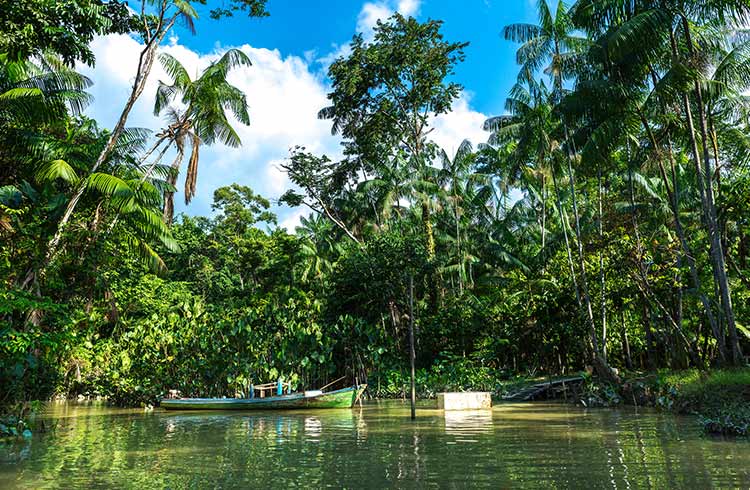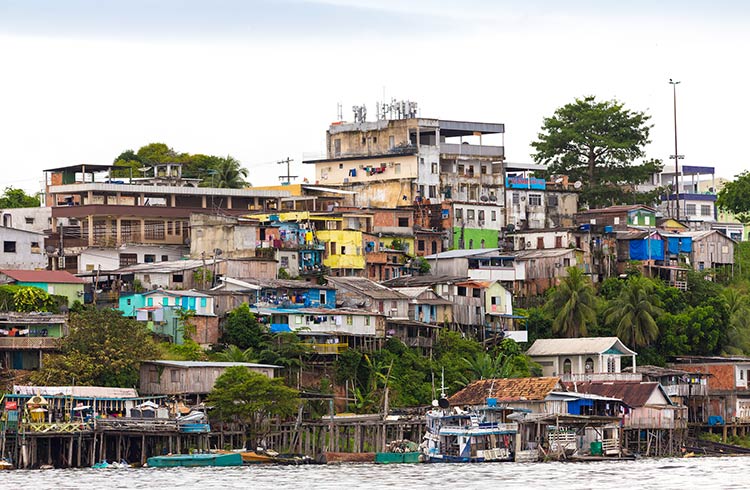How to Prepare for Your First Time in the Brazilian Amazon
What to pack, how to stay healthy, the types of wildlife you will encounter and weather expectations for your trip to the Amazon.
 Photo © Getty Images/felipefrazao
Photo © Getty Images/felipefrazao
Covering more than 2.1 million square miles of tropical terrain, the Amazon rainforest's biodiversity is mind-boggling. Eight of the world’s 20 longest rivers are located in the Amazon basin, where a fifth of Earth's freshwater is found.
More than 20% of the planet's oxygen is produced by the Amazon, but the Amazon floor is a dark place due to the incredibly dense canopy. Regardless of how you experience the legendary rivers, always travel in a group, preferably with a knowledgeable and reputable tour guide.
To visit the rainforest you have two options, you can go thought Belêm (Pará State) or Manaus (Amazônia State). The best place to start is Manaus, with a good range of accommodation options and easy access from major Brazilian airports.
Here are some tips to stay safe and healthy while exploring this wild location.
- How to Stay Healthy in the Amazon
- What to Wear in the Amazon
- What Wildlife Will I See in the Amazon
- Bugs, Sweat and Tears
- Weather in the Amazon
- How to Stay Safe in the Amazon
How to Stay Healthy in the Amazon
Even if you have a steel-like immune system, the Amazon is definitely no picnic when it comes to matters of health and hygiene. The Amazon’s waters teem with parasites and amoebas that can seriously mess with your delicate Western immune system and lead, at best, to that vexing trilogy of vomit, fever and diarrhea, at worst to dysentery, typhoid and cholera. provoke acute and, at times, fatal diseases like Chagas Disease.
The cone-nose (or kissing bug) carries a parasite which transmits the disease. Symptoms include fever, vomiting, skin rash, body aches and more. Chagas Disease is present in 21 Latin American countries and results in about 12,500 deaths a year worldwide.
Of these pesky parasites, it’s the dreaded trematodes that strike fear into the hearts of travelers keen to penetrate the jungle. Also known as flukes, and named for their massive suckers, they are generally found in pools and other contaminated waters. Trematodes burrow their way directly into your body, if you choose, for example, to wade through a swamp. Be sure to wear long pants and boots if your journey involves passing through a swamp.
They can also pass into your system through consuming contaminated water. Always treat your water before consuming it.
Take the customary precautions and make sure your food is fresh and properly washed to reduce your chances of getting sick. Carry a travel first aid kit including medicine that will treat diarrhea and fevers. Where possible also have access to a local pharmacy in case you require stronger medication. For travelers to the Amazon, the biggest (and often life-threatening) threat comes from mosquitoes carrying malaria and yellow fever. Always make sure you are up to date on the recommended vaccinations before you travel and consult the Center for Disease Control for latest advisories concerning your risks of being exposed to malaria.
What to Wear in the Amazon
Long-sleeved shirts, long pants, sturdy hiking boots, a wide-brimmed hat and a waterproof jacket are essential gear for jungle trekking.
Apply DEET strength insect repellent and keep your skin covered as much as possible to avoid insect bites (they are rapacious). For a good night’s sleep, a mosquito net and earplugs (to muffle to sound of gnats buzzing in your ear) might help.
Treat any wounds as soon as possible to avoid infection. Always shake out your boots or shoes before you put them on, in case any creatures have made them home for the night.
What Wildlife Will I See in the Amazon?
This is one of the most species-rich places on earth – to give you a sense of the magnitude, the Negro River has more species than all the rivers in Europe combined.
With frogs the size of rabbits, 30ft long green anacondas, and the black caiman (the largest alligator in the world), there’s no shortage of superlatives to describe the roughly 16,000 species that populate the Amazon. According to scientists, a new species of animal is discovered in the Amazon rainforest every three days.
While, reassuringly, animals will not go out of their way to hunt down humans, the Amazon is full of creatures that will make no bones about attacking you if you display threatening behavior towards them. Aspiring David Attenboroughs should keep their distance.
One of the most beautiful and brightly colored creatures you’ll see in the rainforest, the poison dart frog can emit a deadly poison through their skin capable of causing heart failure within minutes. One impressive subspecies, the golden dart poison frog possesses enough poison to kill up to twenty humans. Then there are the aptly named Assassin bugs which inject poisonous saliva into their prey; it literally broils its victim’s organs. The Amazon River harbors electric eels that can generate five times more electricity than the standard wall socket, as well as blood-sucking leeches and vicious mosquitos that can infect you with a medley of fatal ailments.
Always listen for clues about what is around you, watch where you step and (in the absence of a machete-wielding tour guide) carry a long stick ahead of you to clear your path and help avoid contact with spider webs. Be cautious when touching or handling plants as many have thorns and can be poisonous.
Bugs, Sweat and Tears
Persistent, painful and maddening mosquitoes can make your trip into the Brazilian bush memorable for all the wrong reasons.
Take plenty of high strength insect repellent; (your average stuff just won't work!) and a mosquito net to sleep under. Repellents with high concentrations of DEET will be sure to keep the mozzies off but also strip through plastic and burn the nostrils. If you're worried about glowing or melting, there are plenty of powerful repellents that don't contain DEET.
Higher levels of acidity in the Amazon waters are supposed to mean fewer mosquitoes but don't let your guard down. They're sneaky devils and that's when they're most likely to strike. There may not be as many mozzies buzzing around the river itself but there's no shortage of stagnant pools of rainwater for them to infest.
There are plenty of other things that creep, crawl, slither and stalk in the Brazilian rainforest so keep to the tracks and stay alert for fangs.
Brazil's heat and humidity will cause you to spend a lot of your time sweating. Ensure you don't become dehydrated and keep up your fluid intake, capirinhas don't count!
Although the water in Brazil's cities is quite clean, it's best for tourists to stick to bottled stuff, especially in more remote areas. Coconut water is a tasty alternative, full of calcium and potassium, and a real staple for Brazilians from birth. Seriously, it's prescribed to beef up Brazilian babies. Mineral salts are also good at keeping you hydrated and healthy and they're a great idea when you're hiking in the heat.
High humidity means that despite how much you sweat, very little of it evaporates which interrupts your body's cooling mechanisms, making heatstroke a real danger. Don't overexert yourself, try to keep your head covered and again, stay hydrated.
Cute Thieves
The high percentage of tourists at Foz du Iguazu, plus the falls' isolation from the main town mean crime isn't a huge issue, although that's not an indication to let your guard down.
The biggest threat you're likely to encounter in the Parque Nacional will be to your lunch. The bands of coati that roam the park's paths will seize upon any sniff of food, their bizarre snouts swiveling this way and that, and will pounce on any opportunity to relieve you of your snacks. They may be cute but unless you want to be overrun by banded bandits, don't feed them. There's a reason for all the signs. They will keep pestering and you'll accustom them to humans, meaning the problem will only get worse for those who visit in the future.
Weather in the Amazon
The Amazon rainforest is characterized by heavy rain (up to nine feet per year), intense humidity and heat. Weather can produce dangerous conditions, especially during the height of the rainy season from October to May. Torrential rains during March and April washed out roads and water levels rise dramatically in the Amazon River and its network of tributaries. It is not uncommon for flooding and potent river currents to capsize boats. While the rainier season is prime time for wildlife watching, traveling to the Amazon between June and September generally yields more amenable conditions.
How to Stay Safe in the Amazon
If you were to ever get lost or separated from your group, there are a few survival essentials that are handy to know. Here are a few basic survival tips:
- Don’t freak out. This will waste energy and increase your need for food; move slowly and cautiously
- Walking downhill in the jungle will lead to water, and, usually, water leads to civilization
- Break down whatever challenge you are faced with into small, manageable tasks
- Obtain water. Hoards of insects often imply that there is a water source nearby. Animals will often leave trails that meet near water. If you are really prepared (or paranoid), carry a plastic trowel for digging for water beneath the surface. Ideally, boil any water you find, filter it or add purification tablets to it.
- Never wear wet socks. Over time, persistent moisture can provoke tissue breakdown which would leave your feet at risk from fungal infections
- Leave a trail made from torn clothing or any objects you find (the brighter the better)
- Don’t head in a straight line; weave your way through clearings in the forest
- This is a tough one but try to gather materials to build a shelter on high ground (if possible) to protect yourself from inclement weather, voracious insects and venomous spiders and snakes. A fire will frighten away your predators and attract attention from other travelers
- It’s counter to the plan to accidentally poison yourself; only eat fruits, vegetables and nuts that you are familiar with; cashews, peanuts, starchy root vegetables and citrus fruits are abundant in the Amazon. Always consume fresh fruit or fish (if you are a dab hand at fishing) straight away as it will quickly rot in the heat and humidity.
Related articles
Simple and flexible travel insurance
You can buy at home or while traveling, and claim online from anywhere in the world. With 150+ adventure activities covered and 24/7 emergency assistance.
Get a quote
4 Comments
You need a little more of information for kids
Do you need to add more Details and a little less information for the kids
Great info for the kids!
It is a shame!